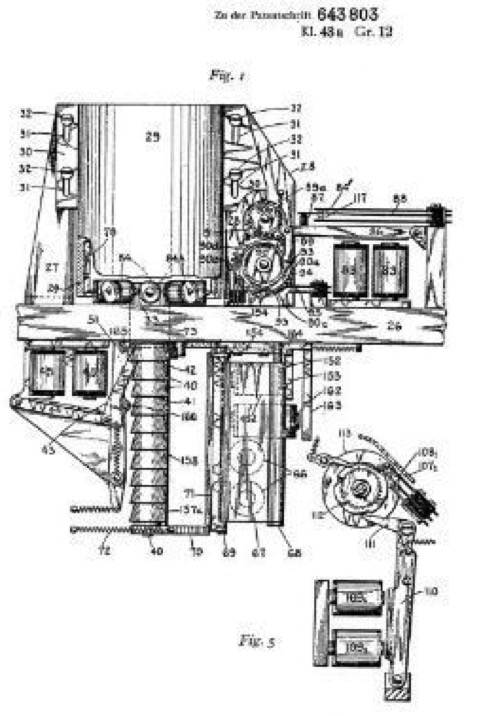History (1932): Tauschek Patents Magnetic Drum Storage, Cylinder Coated With Ferromagnetic Material
Became Univac 1101 after company's acquisition by Remington Rand.
This is a Press Release edited by StorageNewsletter.com on February 16, 2018 at 2:31 pmThis article comes from the Computer History Museum.
1932: Tauschek patents magnetic drum storage
Gustav Tauschek patents cylinder coated with ferromagnetic material
Figure from Taushek’s German Patent (1933)

Working at a punched-card subsidiary of IBM in Sömmerda, Germany in 1932 Austrian engineer Gustav Tauschek (1899-1945) demonstrated and patented a prototype magnetic drum storage device.
Multiple stationary read and write heads each accessed tracks on a cylinder coated with ferromagnetic material that stored 500,000 bits. In 1946, Andrew Donald Booth of the University of London constructed a magnetic drum storage device, 2-inch diameter, and 2-inch long, capable of storing ten bits per inch on a nickel-plated brass drum that is on display in the London Science Museum.
As they were typically more reliable in operation than delay lines and CRTs, drum units were initially employed in immediate access memory applications as well as for storage. William C. Norris of Engineering Research Associates (ERA), Minneapolis, MN, led a group, including engineers John L. Hill and Robert I. Perkins that built a magnetic drum by cementing 3M ferric oxide-coated Mylar tape to a cast aluminum cylinder for a U.S. Navy cryptographic unit in 1947. In 1950 ERA developed an 8.5 inch diameter device with 200 stationary R/W heads and a capacity of 16,384, 24-bit words for the Atlas 1 code-breaking computer that became the Univac 1101 after the company’s acquisition by Remington Rand.
Computing pioneer Howard Aiken employed drum main memory on the Harvard Mark III in 1949. Other early drum memory machines included the Manchester University Mark I (1949), National Bureau of Standards SWAC (1950), and MIT Whirlwind (1951). Commercial drum memory computers included the Univac 1101 (1951), IBM 650 Magnetic Drum Calculator (1953), and English Electric DEUCE (1955).
The IBM 305 RAMAC (1956) employed drum for memory and disk for storage. Drums were displaced by magnetic cores for main memory in the 1950s and by disk drives for storage in the 1960s, but remained in specialized applications into the 1980s. On these later units the magnetic media was deposited directly on the surface of the metal drum.













 Subscribe to our free daily newsletter
Subscribe to our free daily newsletter

